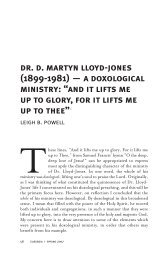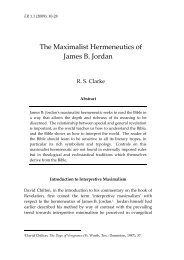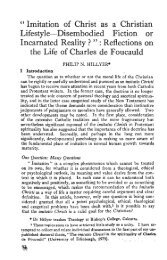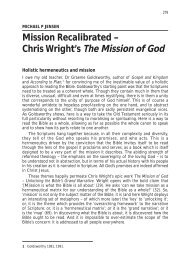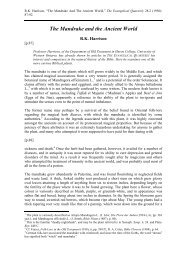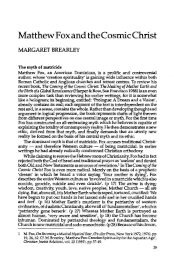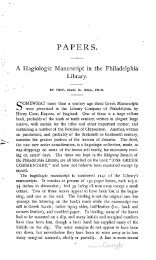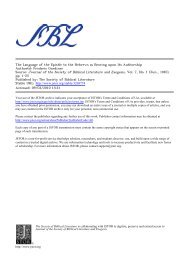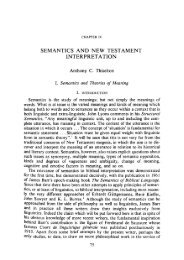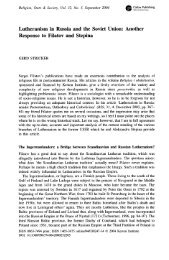Ancient Orient and Old Testament - BiblicalStudies.org.uk
Ancient Orient and Old Testament - BiblicalStudies.org.uk
Ancient Orient and Old Testament - BiblicalStudies.org.uk
Create successful ePaper yourself
Turn your PDF publications into a flip-book with our unique Google optimized e-Paper software.
K.A. Kitchen, <strong>Ancient</strong> <strong>Orient</strong> <strong>and</strong> <strong>Old</strong> <strong>Testament</strong>. London: Inter-Varsity Press, 1966. Hbk. pp.191.<br />
leadership suggest otherwise, as does the analogy of archaeological failure to produce<br />
remains tallying with other - <strong>and</strong> indisputably original - <strong>Ancient</strong> <strong>Orient</strong>al written<br />
documents. 28<br />
[p.65]<br />
The excavations at Gibeon 29 afford a further sharp lesson on the unreliability of negative<br />
evidence: the first three seasons of excavation found no trace of the Late Bronze Age city<br />
presupposed in Joshua 10:2. 30 But in the fourth campaign, the discovery of a few very fine<br />
tombs of that particular period has shown that there must in fact have been a Late Bronze Age<br />
settlement somewhere on the general site as required by Joshua 10:2. 31<br />
With the beginning of the conquest have been associated archaeological destruction-levels at<br />
Lachish (Tell ed-Duweir), Debir (if Tell Beit Mirsim), Bethel (Beitin), Tell el-Hesi (Eglon?)<br />
<strong>and</strong> Hazor (Tell el-Qedah or Wagqas). 32 All of these show traces of catastrophic destruction<br />
in the later part of the thirteenth century BC, although the fall of Bethel has been thought to<br />
be earlier than the others. If one identifies these destructions at Lachish <strong>and</strong> Debir as resulting<br />
from Joshua’s Southern campaign (Jos. 10), the earlier fall of Bethel (before Israel crossed<br />
the Jordan?) might seem a difficulty. To ‘solve’ it by postulating a separate history of the<br />
Joseph-tribes (as some do), or similar counsels of despair, would seem quite unnecessary,<br />
however.<br />
First, the notion that Bethel perhaps fell earlier than Lachish <strong>and</strong> Debir is based on the<br />
superior quality of its pottery compared with that from the destruction-levels at the other two<br />
sites. 33 But this overlooks the fact that all the material culture at Bethel is of a high st<strong>and</strong>ard:<br />
well-built houses, paved or plastered floors, excellent drainage-system, exotic art (‘Astarte<br />
[p.66]<br />
rest on nothing more than mistranslation. Possibly cease shining rather than cease moving should be<br />
understood, <strong>and</strong> for ‘about a whole day’ one may definitely render ‘as when day is done’; cf. provisionally R.<br />
D. Wilson, Princeton Theological Review 16 (1918), pp. 46-54.<br />
28 Thus in Egypt, for example, many stone temples are mentioned in documents (e.g., the great Papyrus<br />
Harris I) or on monuments of their officials, but have never been found by archaeologists. Cf. lists in W.<br />
Helck, Materialen zur Wirtschaftsgeschichte des Neuen Reiches, I, 1961, pp. 137-139 (eight royal funerary<br />
temples never yet found); ibid., II, 1961, pp. 157-190 (temples of provincial capitals, etc.). No trace of<br />
Ninth-Dynasty Heracleopolis has yet been found although that dynasty originated there, <strong>and</strong> so on.<br />
29 On the identification of El Jib as the site of Gibeon on the basis of inscribed jar-h<strong>and</strong>les found there, cf. J.<br />
B. Pritchard, VTS, VII, 1960, pp. 1-2, <strong>and</strong> Gibeon where the Sun stood still, 1962, pp. 45-52 (topographical<br />
indications, ibid., pp. 24-45 passim).<br />
30 Except for a single sherd of Cypriote ware (VTS, VII, p. 8 n. 2), but reported as two sherds of a bowl in BA<br />
24 (1961), pp. 22 - 23.<br />
31 BA, loc. cit.; Gibeon .... 1962, pp. 135-138, 156-158: The Bronze Age Cemetery at Gibeon, 1963.<br />
32 Wright, Biblical Archaeology, 1957, pp. 80-83; with references, JNES 5 (1946), pp. 110-111.<br />
33 Cf. Albright, BASOR 58 (1935), p. 13.




